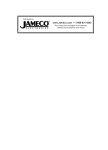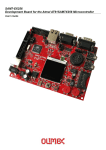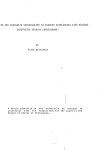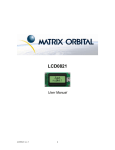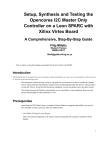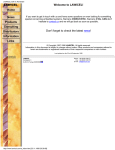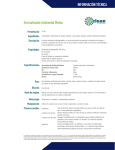Download LCD4041
Transcript
LCD4041 User Manual IMPORTANT: READ PAGE 2 BEFORE APPLYING POWER. Connecting LCD4041 The LCD4041 serial interface has two types of communications: RS-232 and I2C. Power is applied to the white or brown four pin SIP connector as follows: Pin 1: +5Vdc Pin 2: = SCL (I2C clock) Pin 3: = SDA (I2C data) Pin 4: Gnd If the sole data source is via RS - 232, the data input is via the DB-9 connector. Pins 2 and 3 of the four pin SIP connector are not used. Wide Voltage Option (LCD4041-VPT) Power is applied to the white or brown four pin SIP connector as follows: Pin 1: +7 - 15Vdc Pin 2: = SCL (I2C clock) Pin 3: = SDA (I2C data) Pin 4: Gnd If the sole data source is via RS - 232, the data input is via the DB-9 connector. Pins 2 and 3 of the four pin SIP connector are not used. WARNING: DO NOT APPLY ANY POWER WITH REVERSED POLARIZATION. DO NOT APPLY ANY VOLTAGE OTHER THAN THE SPECIFIED VOLTAGE. DO NOT USE ANY CABLES OTHER THAN THE CABLES SUPPLIED BY MATRIX ORBITAL, UNLESS YOU ARE AWARE OF THE MODIFICATIONS REQUIRED. DO NOT UNDER ANY CIRCUMSTANCES USE AN UNMODIFIED FLOPPY DRIVE POWER CABLE. DB-9 Connector Pin Out RS - 232 port: This connector is wired so that a standard “straight through” 9 pin D-sub cable may be used to connect the modules on a standard serial port such as comm ports on PCs. Note that this device complies to the EIA232 standard in that it uses signal levels from +/- 3V to +/- 12V. It will not operate correctly at TTL (0 to +5V) levels. Pin Number Description 2 Data Out 3 Data In 5 Ground 9 +5Vdc Note: Signals are shown as interpreted by the Liquid Crystal Display module. 2 Pin 9 Jumper Point Power may be provided to the module by pin 9 of the DB-9 connector instead of through the 4-pin SIP. If power is to be applied using the DB-9, it must be a regulated +5Vdc supply. If the user intends to use pin 9 as the power source, the user must solder the 5 volt jumper point beside the DB-9 connector. If you have any further questions or concerns don’t hesitate to contact Matrix Orbital at [email protected]. WARNING: USE THIS METHOD OF POWER UP AT YOUR OWN RISK. APPLICATION OF A VOLTAGE TO PIN 9 GREATER THAN 5.5VOLTS WILL CAUSE IMMEDIATE DESTRUCTION OF UNIT AND VOID THE WARRANTY. Note: This applies to wide voltage units (V and VPT extensions) as well as standard 5 volt units. General Purpose Output (GPO) The GPO is meant to be used as a pair. The positive side of the GPO is connected to a power source of +5Vdc supplied by the module at 20mA. The negative side of the GPO is able to find a path to ground through a 240 ohm resistor. This resistor will limit the current flow through a GPO to approximately 20mA in the event of a short circuit. If the device which is being driven by a GPO requires a relatively high current (such as a relay) and has an internal resistance of it’s own greater than 250 ohms, then, the 240 ohm resistor may be shorted. You will find this resistor directly below the negative pin of the general purpose output. Note: This operation requires soldering. The GPO does not have any over current or over/under voltage protection so care must be taken if the user decides to connect the negative side differently. For instance if the external device is a relay it must be fully clamped to absorb any generated back electromotive force (EMF) 3 Command Set Write Text This section of the manual allows the user to send commands to the LCD to alter the appearance or behavior of the display. To utilize a command, the user must send a command prefix followed by the command in the format described in this portion of the manual. Any characters sent without a command prefix will be interpreted as text and will be displayed on the module at the current cursor position. The current cursor position will be incremented for each character received. Please note that unless line wrap is turned on, the text will follow the memory map of the module. The command set discusses in detail what the LCD's capabilities of and how to execute each command. The basic format of all the commands listed in this segment that do not require parameters is: <command prefix><command> For commands that do require parameters however the format is as follows: <command prefix><command>[<parameter><parameter>.....] Set I²C Address ASCII '3', Hex 33, Decimal 51 Syntax 0xFE 0x33 To write the I²C address of the module, send a command prefix followed by the character '3', followed by a write address. This command sets the I²C write address of the module. This value must be an even number and the read address is one higher. For example if the I²C write address is set to 0x50, then the read address is 0x51. The change in address is immediate. This address is 0x50 by default, and is reset temporarily back to that value when the "Manual Over-ride" jumper is used on power up. Refer to the Appendix for more details. Set Serial Number ASCII '4', Hex 34, Decimal 52 Syntax 0xFE 0x34<serial number byte one><serial number byte two> To set the serial number of the module, send a command prefix followed by the character '4', followed by two values defining the first and second serial byte. This command sets the two byte serial number of the module. Upon the execution of this command, the module will echo these two bytes back over the RS-232 interface. The serial number may be set only once. Any future attempt to execute this command will result in no change and the module will return to the originally set serial number. Read Serial Number ASCII '5', Hex 35, Decimal 53 Syntax 0xFE 0x35 To read the serial number, send a command prefix followed by the character ‘5’. This command will return, over the RS-232 interface, the serial number of the module as it was previously stored. Read Version Number ASCII '6', Hex 36, Decimal 54 Syntax 0xFE 0x36 To read the version number send a command prefix followed by the character '6'. This command will return, over the RS-232 interface, the firmware revision number of the module as it is stored. 4 Read Module Type Value ASCII '7', Hex 37, Decimal 55 Syntax 0xFE 0x37 To read the module type value, send a command prefix followed by the character '7'. This command will return, over the RS-232 interface, the model type value of the module. Values for various modules at the time of this publication are as follows: LCD0821 – 0x01 LCD2041 – 0x05 LK202-25 – 0x08 VFD2021 – 0x0B VK202-25 – 0x0E GLC12864 – 0x11 GLK12864-25 – 0x14 GLK12232-25 – 0x22 LK402-12 – 0x33 LCD2021 – 0x03 LCD4021 – 0x06 LK204-25 – 0x09 VFD2041 – 0x0C VK204-25 – 0x0F GLC128128 – 0x12 GLK24064-25 – 0x15 LK404-AT – 0x31 LK162-12 – 0x34 LCD1641 – 0x04 LCD4041 – 0x07 LK404-55 – 0x0A VFD4021 – 0x0D GLC12232 – 0x10 GLC24064 – 0x13 GLK128128-25 – 0x21 VFD1621 – 0x32 LK204-25PC - 0x35 Set RS - 232 Port Speed ASCII '9', Hex 39, Decimal 57 Syntax 0xFE 0x39<speed> To set the RS-232 port speed, send a command prefix followed by the character '9', followed by a value defining the desired<speed>. This command sets the LCD's RS-232 port to the specified<speed>. The change takes place immediately. <speed> is a single byte specifying the desired port <speed> Valid speeds are shown in the table below. The LCD can be manually reset to 19,200 baud in the event of an error during transmission (including transmitting a value not listed below). Refer to the appendix for details. Load New Start Up Screen ASCII ‘@’, Hex 40, Decimal 64 Syntax 0xFE 0x40<160 characters> Hex Value FF Hex 81 Hex 20 Hex 0F Hex Speed 1200 baud 2400 baud 9600 baud 19200 baud This command allows you to load a new start up screen. To execute this you must send a command prefix followed by the character '@', followed by 160 characters to format the screen to your specifications. The characters on the module should be formatted as shown in the diagram. Character 1 Character 41 Character 81 Character 121 ------------------------------------------------------------------------------------------------------------------------------------------------------------------------------------- Character 40 Character 80 Character 120 Character 160 Set Contrast ASCII 'P', Hex 50, Decimal 80 Syntax 0xFE 0x39<contrast> To set the contrast of the display, send a command prefix followed by the character 'P', followed by a hex value defining the contrast. This command sets the display's contrast to <contrast>, where <contrast> is a value between 0x00 and 0xFF (between 0 and 255). Lower values cause “on” elements in the display area to appear lighter, while higher values cause “on” elements to appear darker. Lighting conditions will affect the actual value used for optimal viewing. Individual LCD modules will also differ slightly from each other in appearance. In addition, values for optimal viewing while the LCD backlight is on may differ from values used when backlight is off. 5 Set Contrast and Save Value Hex 91, Decimal 145 Syntax 0xFE 0x91 This command works in exactly the same way as the “Set Contrast” command. The only difference is it saves the contrast value in the memory of the module, whereas, the previous command only changes the value for the duration of use. Auto Line Wrap On ASCII 'C', Hex 43, Decimal 67 Syntax 0xFE 0x43 This command enables the automatic line wrap function. Transmitted characters which overrun the width of the display will automatically wrap to the next line. The bottom line wraps to line 1 of the display. To carry out this command the user must send a command prefix followed the character 'C'. Auto Line Wrap Off ASCII 'D', Hex 44, Decimal 68 Syntax 0xFE 0x44 This command disables the automatic line wrapping function. To turn off the auto line wrapping, send a command prefix followed by the character 'D'. Auto Scroll On ASCII 'Q', Hex 51, Decimal 81 Syntax 0xFE 0x51 To turn the automatic line scrolling on, send a command prefix followed by the character 'Q'. In combination with the “Auto Line Wrap” command the text will automatically wrap and scroll up. Note: “Auto Line Wrap” must be enabled for “Auto Scroll” to work properly. Auto Scroll Off ASCII 'R', Hex 52, Decimal 82 Syntax 0xFE 0x82 To turn the automatic line scrolling off, send a command prefix followed by the character 'R'. Backlight On ASCII 'B', Hex 42, Decimal 66 Syntax 0xFE 0x42<number of minutes> To turn the backlight on, send a command prefix followed by the character 'B' as well as the number of minutes for the backlight to be activated. If <minutes> is sent as zero then the backlight will remain on indefinitely. The maximum value for <minutes> is 100. Example: <command prefix> <command> <minutes> 0xFE 0x42 0 to 100 Backlight Off ASCII 'F', Hex 46, Decimal 70 Syntax 0xFE 0x46 To turn the backlight off, send a command prefix followed by the character 'F'. 6 Clear Display ASCII 'X', Hex 58, Decimal 88 Syntax 0xFE 0x58 This command clears any text and graphics off the display. To clear the display, send a command prefix followed the character 'X'. Cursor On ASCII 'J', Hex 4A, Decimal 74 Syntax 0xFE 0x4A To turn the cursor on at the current position, send a command prefix followed by the character 'J'. Note cursor is on by default at power up. Cursor Off ASCII 'K', Hex 4B, Decimal 75 Syntax 0xFE 0x4B To turn the cursor off at the current position , send a command prefix followed by the character 'K'. Cursor Left ASCII 'L', Hex 4C, Decimal 76 Syntax 0xFE 0x4C To move the cursor one space to the left of current position, send a command prefix followed by the character 'L'. Cursor Right ASCII 'M', Hex 4D, Decimal 77 Syntax 0xFE 0x4D To move the cursor one space to the right of the current position, send a command prefix followed by the character 'M'. Cursor Blink On ASCII 'S', Hex 53, Decimal 83 Syntax 0xFE 0x53 To turn on the blinking cursor at the current position, send a command prefix followed by the character 'S'. Please note that the blinking cursor is on by default at power up. Cursor Blink Off ASCII 'T', Hex 54, Decimal 84 Syntax 0xFE 0x54 To turn off the blinking cursor at the current position send a command prefix followed by the character 'T'. Create Custom Character ASCII 'N', Hex 4E, Decimal 78 Syntax 0xFE 0x4E<character between 0x00 and 0x07><8 bytes> This command creates a custom character. For the LCD4041 the user can have up to eight custom characters. To execute this command, send a command prefix followed by the character 'N'. The display will now await the number which identifies the custom character. This number must be between 0x00 and 0x07. When the module determines what character it's working on, then the user must send 8 bytes. This defines the display character. See the diagram below for and explanation of the display character structure. 7 Diagram A MSB * * * * * * * * * * * * * * * * * * * * * * * * 1 6 11 16 21 26 31 36 2 7 12 17 22 27 32 37 3 8 13 18 23 28 33 38 4 9 14 19 24 29 34 39 5 10 15 20 25 30 35 40 LSB Data Byte 1 Data Byte 2 Data Byte 3 Data Byte 4 Data Byte 5 Data Byte 6 Data Byte 7 Data Byte 8 Pixel Layout of Display Characters 1 6 11 16 21 26 31 36 2 3 4 5 7 8 9 10 12 13 14 15 17 18 19 20 22 23 24 25 27 28 29 30 32 33 34 35 37 38 39 40 Cursor Line General Purpose Output On ASCII 'W', Hex 57, Decimal 87 Syntax 0xFE 0x57 To turn the general output purpose on, send a command prefix followed by the character ‘V’. Note: The output is a current sink (Max 20mA) General Purpose Output Off ASCII 'V', Hex 56, Decimal 86 Syntax 0xFE 0x56 To turn the general output purpose off, send a command prefix followed by the character 'W'. Go To Position ASCII 'G', Hex 47, Decimal 71 Syntax 0xFE 0x47<column number><row number> Set the current position. Send a command prefix followed by the character 'G' and two numbers defining in order, the column to move to and the row to move to. The format for column 20 and row 3 would be: <command prefix> <command> <column number> <row number> 0xFE 0x47 0x14 0x03 Go To Top Left ASCII 'H', Hex 48, Decimal 72 Syntax 0xFE 0x48 To reset the current position to top left, send a command prefix followed by the character 'H'. In the following example the format is displayed for this command. 8 Initialize Large Digits ASCII 'n', Hex 6E, Decimal 110 Syntax 0xFE 0x6E Before any large digits may be created, this command must be executed. It only needs to be sent once to initialize the custom characters for large digits. Due to the fact large digits use pre-determined custom characters, no user custom characters may be displayed or created while digits are in use. Place Large Digit ASCII '#', Hex 23, Decimal 35 Syntax 0xFE 0x35<column number><digit number> This command allows the creation of large digits on the LCD screen. To execute this command the user must send a command prefix followed by the character '#' and the column number where the digit is to be placed. Then the user must enter the number of the large digit which is required in hexadecimal. Numbers of almost full display height may be placed along side regular text on four row displays. The column number has a maximum value which is less than the display width because the digits are all three columns wide. The module must be initialized for large digit creation before large digits may be placed. If regular text and large digits are mixed on one screen, the user should always set the display cursor position before placing regular text because the creation of a large digit will leave the cursor position to the bottom right of the large digit and not at the last regular text write position. The format for this command is as follows: <command prefix> <command> <column number> <digit number> 0xFE 0x23 0x01 to 0x26 (1 to 38 for a 40 column display) 0x00 to 0x09 (numbers 0 to 9) Initialize Horizontal Bar Graph ASCII 'h', Hex 68, Decimal 104 Syntax 0xFE 0x68 Before any horizontal bar graphs may be created, this command must be executed. It only needs to be sent once to initialize the custom characters for bar graph creation. Due to the fact bar graphs use custom characters, no user custom characters may be displayed or created while bar graphs are in use. Make Horizontal Bar Graph ASCII '|', Hex 7C, Decimal 124 Syntax 0xFE 0x7C<column number><row number><direction><bar length> This command places a horizontal bar graph at the specified column and row with the specified width. The format of the command is as follows: <command prefix > <command> <column number> <row number> <direction> <bar length> 0xFE 0x7C 0x01 to 0x28 for a forty column display 0x01 to 0x04 for a four line display 0 for left to right, 1 for right to left 0x00 to 0xC8 (0 to 200) for a forty column display Bar length is in pixel widths. On a forty column display the maximum bar graph width is two hundred pixels (if the bar graph starts at the edge). This is due to the fact that each of the forty columns on the display are five pixels wide. The width of the space between columns is not taken into account. 9 Initialize Thick Vertical Bar Graph ASCII 'v', Hex 76, Decimal 118 Syntax 0xFE 0x76 Before any thick vertical bar graphs may be created, this command must be executed. It only needs to be sent once to initialize the custom characters required for bar graph creation. Due to the fact bar graphs use custom characters, no user custom characters may be displayed or created while bar graphs are in use. Initialize Thin Bar Vertical Graph ASCII 's', Hex 73, Decimal 115 Syntax 0xFE 0x73 Before any thin vertical bar graphs may be created, this command must be executed. It only needs to be sent once to initialize the custom characters required for bar graph creation. Due to the fact bar graphs user custom characters, no user custom characters may be displayed or created while bar graphs are in use. Make Vertical Bar Graph ASCII '=', Hex 3D, Decimal 61 Syntax 0xFE 0x3D<column number><bar length> This command places a bar graph at the specified column with the specified height. The style of the vertical bar graph whether it be thick or thin is selected by the initialize vertical bar graph command. If thick bar graphs are preferred, the 'v' command should be sent to initialize the bar graph. If a thin vertical bar graph is desired, the 's' command should be sent to initialize the bar graph. The format for the command is as follows: <command prefix> <command> <column number> <bar length> 0xFE 0x3D 0x01 to 0x28 for a forty column display 0x00 to 0x20 (1 to 32) for a four line display. Bar height is in pixel widths. On a four line display the maximum bar graph height is thirty-two, this is because each of the lines in the display are eight pixels high. The width of the space between the lines is not taken into account. Note: Vertical bar graphs may not be used with horizontal bar graphs, and thick bar graphs may not be used with thin bar graphs. This is because all these functions make use of the same “custom character” spaces. As a result, custom characters are also unavailable while any of these functions are in use. 10 LCD Character Font Chart 11 Specification Sheets Environmental Specifications Operating Temperature Storage Temperature Operating Relative Humidity Standard Temp. Extended Temp. 0º to +50º C -20º to +70º C -20º to +70º C -40º to +85º C 90% max non-condensing Electrical Specification Supply Voltage Supply Current Backlight Supply Current 4.75 - 5.25 Vdc (optional 7 - 15Vdc) 25mA typical 150mA typical Optical Specifications Number of characters Matrix format Display area Character size Character pitch Line pitch Dot size Dot pitch LED Backlight life Color of illumination 160 (40 Characters x 4 Lines) 5 x 7 with underline 140.45 x 23.16mm (XxY) 2.78 x 4.89mm (XxY), not including underline 3.53mm 6.09mm 0.50 x 0.55mm (XxY) 0.57 x 0.62mm (XxY) 100,000 hours typical Yellow green 12 LCD4041 13 Appendix Hexadecimal Hex numbers are specified in C language convention as 0xUL - where U is the upper nibble and L is the lower nibble. Eg: 0xFE is 1111 1110 in binary. This is equivalent to ULH or ULh as in the binary number 1111 upper nibble 1110 lower nibble .....which would be FEH or FEh Manual Over-ride Manual override should only be required in one instance. If for some reason the module is set at a baud rate which cannot be produced by the host system and all communication to the display is lost, then the user should follow this simple procedure: 1) 2) 3) 4) 5) 6) Turn off the display Place a jumper on the two pin strip header indicated on the diagram as the Manual Over-ride Jumper. Power up the display. Remove the jumper and change the RS-232 port settings to a baud rate recognized by the host system using the “Set RS-232 Port Speed” command. Turn off the display. Power up the display. Refer to the “Set RS-232 Port Speed” command for acceptable baud rates. 14 NORTH AMERICA EUROPE CANADA AUSTRIA HVW Technologies Suite 473, 300 - 8120 Beddington Blvd. N.W. Calgary, Alberta T3K 2A8 Canada Telephone: +1 403 730 8603 Facsimile: +1 403 730 8903 Email: [email protected] WWW: http://www.hvwtech.com/ MEGATON Ges.m.b.H. Franz-Schubert-Gasse 12, A-2372 GIESSHÜBL Telephone : +43 0 2236 43179 Facsimile : +43 0 2236 4317921 Email: [email protected] Tri-M Systems Inc. 6-1301 Ketch Court Coquitlam, BC V3K 6X7 Canada Toll Free Telephone: 1 800 665 5600 Alternate Telephone: +1 604 527 1100 Facsimile: +1 604 527 1110 Email: [email protected] WWW: http://www.tri-m.com/ Symmetric Oy Maria Jotunin Tie 11 Helinski, Finland 00400 Telephone: + 358 9 5885 322 Facsimile: + 358 9 5885 578 Email: [email protected] WWW: http://www.symmetric.fi/ UNITED STATES EMJ Embedded Systems Suite 100-1434 Farrington Road Apex, North Carolina 27502 USA Toll Free Telephone: 1 800 436 5872 Facsimile: +1 919 363 4425 Email: [email protected] WWW: http://www.emjembedded.com/ FINLAND GERMANY Elektronikladen Mikrocomputer Gmbh Offices throughout Germany Telephone : +49 0 5232 8171 Facsimile : +49 0 5232 86197 Email: [email protected] WWW: http://www.elektronikladen.de/ THE NETHERLANDS Jameco Electronic Components 1355 Shoreway Road Belmont, California 94002-4100 US Toll Free Telephone: 1 800 831 4242 Toll Free Facsimile: 1 800 237 6948 Email: [email protected] WWW: http://www.jameco.com/ Antratek Electronics Kanaalweg 33, NL-2903LR Capelle aan den Ijssel, The Netherlands Telephone :+31 10 4504949 Facsimile : +31 10 4514955 Email: [email protected] WWW: http://www.antratek.nl Note: Currently only carries LCD2041, LK204-25 ITALY Linux Central Suite T2 37060 Garfield Clinton Township, Michigan 48036 USA Telephone: +1 810 226 8200 Toll Free Telephone: 1 877 LINUX CD (546 8923) Facsimile: +1 810 226 8600 Email: [email protected] WWW: http://linuxcentral.com/ QuadriviumNET Via Circonvalazione Sud, 76 33033 Codriopo, Udine, Italy Telephone : +39 0 432 906062 Facsimile : +39 0 432 901514 Email: [email protected] WWW: http://www.qnet.it/ 15 SCANDINAVIA ASIA Lawicel Klubbgatan 3 SE-282 32 Tyringe, Sweden Telephone: +46 0 451 598 77 Facsimile: +46 0 451 598 78 Email: [email protected] WWW: http://www.lawicel.com INDIA Lilla Fabriken Box 1003 SE-172 21 Sundbyberg, Sweden Telephone: +46 8 287 286 Facsimile: +46 8 288 802 Email: [email protected] WWW: http://www.lillfab.se SWITZERLAND Bernhard Elektronik Aarauer Str. 20, CH-5734 Reinach AG Telephone : +41 0 62 7716944 Facsimile : +41 0 62 7716944 Email : [email protected] AL Systems 105, 3rd Street, Tatabad, Coimbatore - 641012 Tamil Nadu, India Telephone: +91-422-233166, 493960 Facsimile: +91-422-230958, 213849 Email: [email protected] WWW: http://business.vsnl.com/al_systems AFRICA EGYPT AmGroup 13 Sheraton Heliopolis Zone 8, Cairo EGYPT Email: [email protected] MIDDLE EAST ISRAEL Alpha Terminals & Printers Ltd. 7 Ha'Mifalm St. Petach - Tikva, Israel 49250 Telephone: +972 3 9214422 Facsimile: +972 3 9219966 Email: [email protected] AUSTRALIA AUSTRALIA Alfa-Tek Unit 7, 42 - 50 Stud Road Bayswater, Victoria, Australia, 3111 Telephone: + 61 39 720 5344 Facsimile: + 61 39 720 5268 Email: [email protected] WWW: http://www.alfatek.com.au/ 16 Contact Information To request information or purchase any of Matrix Orbital Corporation's products contact one of our Authorized Distributors. For technical questions and support please contact us. Sales/Accounts Chantelle Jenkins [email protected] Technical Support Aman Sidhu [email protected] Lead Project Engineer Rob Hansen [email protected] Tel: (403) 229-2737 Fax: (403) 229-1963 Or visit us at our website: http://www.matrix-orbital.com Matrix Orbital 2000. The information contained here in is subject to change without notice. Matrix Orbital Corporation assumes no responsibility for the use of circuitry embodied in a Matrix Orbital product. Matrix Orbital does not authorize it’s products for use as critical components in life-support systems where a malfunction or failure may reasonably be expected to result in significant injury to the user. The inclusion of Matrix Orbital products in life support system applications implies that the manufacturer assumes all risk of such use and in doing so indemnifies Marix Orbital of any charges.


















